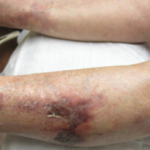In May’s “Rheuminations” column (“Make Peace with Complexity,” p. 6), we asked how you would manage gout in a patient with multiple comorbidities and complications. (See the full description at right.) We received an overwhelming number of letters recommending a range of treatment approaches. We’ve published a selection of those responses here, and we want to thank everyone who wrote in. Keep those letters coming!
—The Editors
The Patient
- Seventy-two-year-old man with heart failure;
- Taking oxygen, furosemide, and coumadin;
- Ejection fraction of 20, creatinine of 2.5, blood urea nitrogen of 60, INR near 3; and
- Fever and an infiltrate on chest X-ray that could be pneumonia, atelectasis, or pulmonary congestion.
Readers’ Treatment Strategies
Tylenol #3. Actually, I would consider a steroid taper, also, since the immunosuppression issue is probably overstated.
J. Stephen Thompson, MD, Rheumatologist
Arthritis Center of the Rockies, Loveland, Colo.
No non-steroidal anti-inflammatory drugs (NSAIDs) or colchicine. Ice works well for pain—so do narcotics, though with his respiratory status, I’m not so keen on them. I favor an intra-arterial steroid. If you’re nervous about causing a hemarthrosis, perhaps give it under ultrasound guidance. I’ve never had a problem with intra-articular bleeding in patients on warfarin with either joint injection or aspiration.
My counter-case to yours was a file I was asked to review as a medicolegal expert: A young man with congenital heart disease on warfarin went to the emergency room with one swollen, painful joint. Aspiration was not done because he is on warfarin. Instead the doctor stopped the drug, thinking he had a hemarthrosis. While off warfarin, he stroked out from a cardiac embolus. Later he had recurrent acute monoarthritis that turned out to be gout! The emergency room doctors were sued.
My literature review for that indicated that most who considered the matter felt it was safe to aspirate or inject a joint even in an anti-coagulated patient. Some suggested a smaller caliber needle as a precaution and increased pressure on the site after.
Philip Baer, MDCM, Rheumatologist
Malvern Medical Arts Centre, Toronto, Ontario
What I would do for the patient, in order of preference:
- Intra-articular steroids (as long as I felt the knee was not infected);
- Adrenocorticotropic hormone (ACTH); or
- Systemic corticosteroids if the patient is adequately covered for infection with antibiotics, but I would try a low to moderate dose (20 mg to start with rapid taper). This option is not very good, not only because of infection concerns but also because it could cause fluid retention.
Bonita Libman, MD, Associate Professor of Medicine
University of Vermont, Burlington
I would have no problem injecting the knee with corticosteroids with an INR (international normalization ratio) around 3. I have injected many joints under these circumstances without any complications (just have an experienced hand perform it). Intravenous (IV) steroids can also be used.
I think that steroid use for brief periods is safe (again, from personal experience). How many chronic obstructive pulmonary disease (COPD) patients with exacerbations from pneumonia are given IV steroids without terrible consequences? I feel that steroids are given a bad rap and in short bursts, as used for treating gout—especially with NSAIDs contraindicated—they are a viable option.
With creatinines of 1.5 to 1.8 in a similar setting, IV colchicine can be tried at 1 mg and possibly repeated in 24 hours. I have used this administrative route many times in the past with good results. The referring attending is always reluctant to use it as well and, unfortunately, formularies are following suit.
Steve Fink, DO, Chief of Rheumatology
VA Medical Center, Seminole, Fla.
The patient most likely has gout, but he could have a septic knee. I feel you have no choice but to aspirate his knee. I have aspirated and injected hundreds of joints in patients on coumadin. To my knowledge, none has developed a hemarthrosis. Given your patient’s circumstances I would have no problem aspirating his knee. If crystals were seen and the gram stain is negative, I would then treat with intra-articular steroids.
IV colchicines are not on formulary in many hospitals and a bad idea with elevated creatinine. ACTH is not much different than exogenous steroids, but would be my second option.
James S. Cohen, MD, Rheumatologist
Arthritis Care Center, Indianapolis, Ind.
I think I’d vote for an intra-articular injection of steroids as long as some antibiotics were already on board, and I’d strongly consider colchicine 0.6 QOD or Q3D to prevent future flares, as the likely trigger of lasix with congestive heart failure is going to continue. Perhaps the risk of an intra-articular bleed with an INR of 3 is less than the likely morbidity of ensuing inflammation in that knee.
Jonathan Samuels, MD, Director, Clinical Immunology Laboratory
NYU Hospital for Joint Diseases, New York City
I would have given IV colchicine, 1 mg x1, to your elderly man with gout on top of multisystem failure.
Ronenn Roubenoff, MD, MHS
Senior Director, Immunology Medical Research
Biogen Idec, Inc., Cambridge, Mass.
In the old days, acute attacks were attenuated with ACTH and I have seen this work on several occasions. In your case, this might be like flogging a very tired horse. I doubt anyone could argue that a low, physiologic dose of systemic corticosteroid (prednisolone <8mg/d) produces immunosuppression and might be sufficient for the acute attack. If your patient had a brochospastic component, the pulmonary specialist would likely have recommended >2 mg/kg Q8hr with impunity. I would also give colchicine 0.6 mg BID for prophylaxis.
Matthew O. Swartz, MD, Rheumatologist
Prince William Hospital, Manassas, Va.
I suggest either a moderated dose of systemic corticosteroids (i.e., prednisone 10 to 15 mg daily with a tapering regimen over two weeks) with continued close monitoring of fluid status or, if a clinician were feeling cavalier (vs. naive) enough or truly believed in his or her dexterity with a needle, an intra-articular corticosteroid injection to the affected gouty joint.
I recently had a similar situation and was able to maneuver a pleasant elderly woman out of it with the former tactic (though she had several affected gouty joints). Additionally, I have previously provided intra-articular corticosteroid injections to gouty joints in individuals who were anti-coagulated with thankful success. (Whether I possessed the correct thought process in attempting such a procedure under those conditions can be debated.) But I count my lucky stars that those individuals were able to avoid any complications from the procedure.
Lastly, I would also determine which option the treated individual prefers and/or is comfortable with and base my ultimate decision on their preference.
Dennis M. Liu, MD, Rheumatologist
Tuality Community Hospital, Hillsboro, Ore.
I have treated similar patients by injecting the joint with a 27-gauge, 1.5-inch needle. No problem with hemostasis.
Benjamin Lechner, MD, Rheumatologist
Hallandale, Fla.
Your patient was characteristic of 95% of those we now see, and meets “Lightfoot’s Criteria for Gout Needing a Rheumatologist”:
- Veteran;
- Heavy smoking history;
- Bruits in at least six sites, including at least one renal artery;
- Ejection fraction less than or equal to 25%;
- Creatinine around 2.5mg/dL on his or her best day;
- On coumadin for at least two of the following reasons:
- Ventricular dilation with akinetic areas;
- Recurrent thrombophlebitis;
- Recurrent arterial thrombi from their plaques; and
- An artificial heart valve.
- Enough exposure to alcohol to compromise easy regulation of prothrombin times; and
- Bronchopneumonia from tobacco-related lung disease.
In that setting, every drug for gout is contra-indicated. Therefore, the clinical decision-making is easy. You use the drug that is least worst.
I would use, briefly, steroids systemically. (Many are already on them for COPD.) I would also hold coumadin for a few days to tap the joint, as a septic joint in the face of pneumonia is a real possibility.
Robert Lightfoot, MD, Professor of Medicine, Rheumatology Division
University of Kentucky College of Medicine, Lexington

